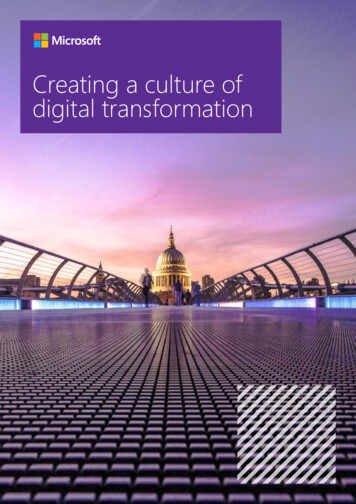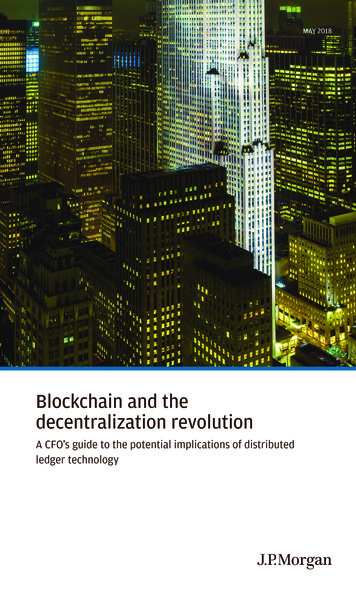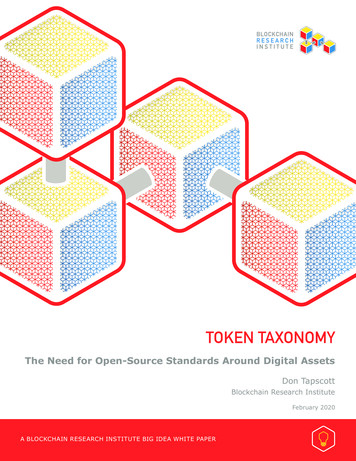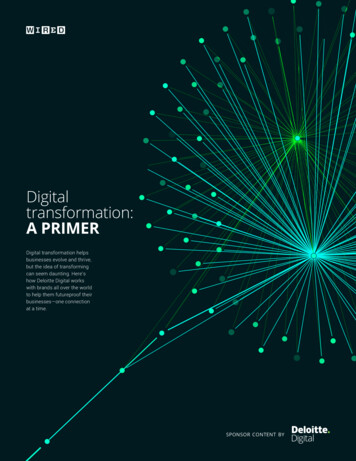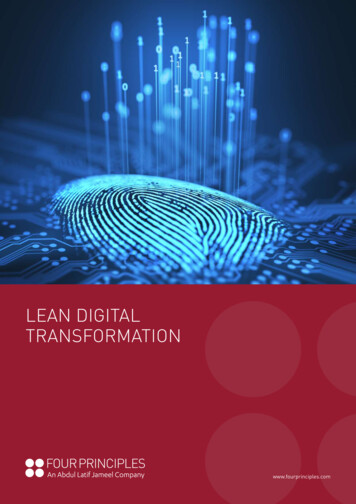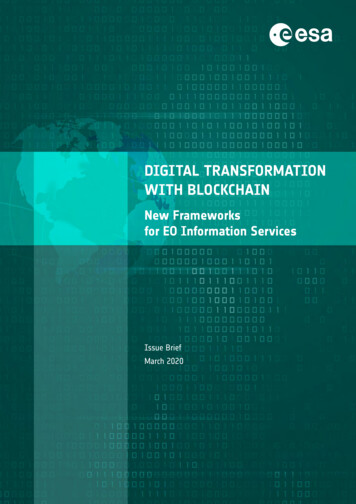
Transcription
DIGITAL TRANSFORMATIONWITH BLOCKCHAINNew Frameworksfor EO Information ServicesIssue BriefMarch 2020
The European Space Agency’s (ESA) role is to catalyse European innovation within the Earth Observation sectorby introducing new ideas, featuring new methods and systems and enabling bold and innovative solutions.In 2019 ESA has released a White Paper on “Blockchain and Earth Observation” to define the key focus areasfor the EO community to explore in the context of the Space 4.0 and future digital engineering for spacemissions. This publication is an “Issue Brief” by the ESA Blockchain / Distributed Ledgers and EO Communityof Practice (CoP) and providing in-depth analysis of one of the priority actions identified by the White Paper forimplementation as a part of the DLT technology research, development and proofing. The version of this articlehas been published by the “Blockchain: Law and Governance” Springer Book, 2020.How to cite this report: Anna Burzykowska, Digital Transformation with Blockchain, New Frameworks for EOInformation Services, March 2020
TABLE OFCONTENTIntroduction4Earth Observation and the cadastral intelligence6Blockchain revolution8EO and blockchain crossover10The next generation of the agriculture value chains11Need for further research and development16Conclusion173DIGITAL TRANSFORMATION WITH BLOCKCHAIN Issue Brief
INTRODUCTIONThe 2018 ESA White Paper on “Blockchain and Earth Observation” refers to theblockchain technology (and other forms of distributed ledgers) as a revolutionary toolfor the future growth of the global digital economy1. Blockchain’s main potential laysin replacing monolithic and centralised data management structures by a distributedsystem, in which people and organisations can participate in trustworthy, secure,transparent networks that enable a direct collaboration (peer-to-peer). It offers thevision of a data ecosystem where information and digital value exchange can beconducted in a verifiable and privacy-preserving way, and with full and automatictraceability of all transactions (data processing and value chains).The blockchain industry is currently at the center of the European agenda for theso-called “Deep Tech” industries which span all key cutting-edge disciplines such asArtificial Intelligence (AI), quantum computing, computer vision, robotics, nanotech,and, indeed, blockchain. As a result, the conceptual applications of distributedledgers, their business potential, and implementation feasibility have grasped theinterest of governments, investors as well as the rapidly accelerating communityof developers and users of distributed applications (DApps). The report releasedby McKinsey in 2019 has nevertheless stated that while many prototypes havebeen built between 2017 and 2019, “the blockchain applications have not yetseen the application at scale”.2 This is why blockchain is often referred to as anemerging technology, one that, much as AI, will develop to the full maturity inthe next five to ten years (possibly faster). Nevertheless, even today, at this earlystage of adoption, there are important characteristics of the blockchain-based dataarchitectures that call for a deeper insight into the driving forces which enablethese first pilot applications, and the foresight into the future use case scenariosthat will be revealed in the 2020 decade, once the technology proves added valueand becomes mainstream.This paper focuses on the two application areas where the blockchain technology(distributed ledgers) intersects with the Earth Observation (EO) technology:blockchain-based land registries and data value chains for natural resourcesmanagement. They both have made important progress in the past two-tothree years and made a direct impact on our understanding of how the digitalrepresentation of physical assets and transactions can transform the economicenvironment around the land administration and management. In this contextEarth Observation technology provides the network of sensors that can connectthe physical environment to various (centralized and decentralized) digital datarepositories. This concept is known as a Digital Twin though which it is possibleto apply EO-based imagery to derive information corresponding to the physicalrepresentation of natural and man-made objects. Blockchain, on the other hand,is a technology through which a record of this data (and the processing chain)can be conveyed and shared across the product value chain. One of the blockchainobjectives is therefore to provide transparency and traceability of the data flow: EOdata, logistics data, socio-economic data, financial data, trade data, etc. In otherwords, the emerging distributed end-to-end platforms certify where the data iscoming from, who collected it, how it was processed, what happened to it as itwent through the value chain, and provide accountability of all of the transactionsand processing steps. In data science it is referred to as a Verifiable Claims DataModel through which the data shared across the parties to the distributed networkis linked, cryptographically secure, privacy respecting, and machine-verifiable3.4DIGITAL TRANSFORMATION WITH BLOCKCHAIN Issue Brief
Such machine-readable information, is further considered a foundation for a newdata retrieval and processing model, called federated learning (or decentralized AI),which is based on the availability of a massive, multisource and real-time datathrough a range of sensors currently being deployed (i.e. satellite sensors, Internetof Things sensors), which coupled with blockchain and Artificial Intelligenceanalytics is expected to underpin the next generation of information services4.This paper focuses on the few selected case studies that show the potentialfor the convergence of EO and blockchain platforms to demonstrate the cuttingedge thinking about how EO technology can be used to advance development ofblockchain applications, how blockchain can be incorporated into EO product andservice design, and what sorts of new tools and methods can be built on blockchainand EO cross over. These case studies are related to land tenure, agricultureand forestry value chains where several important proofs-of-concept have beendeveloped to shed more light concerning the feasibility and lessons learnt from thefirst implementations.5DIGITAL TRANSFORMATION WITH BLOCKCHAIN Issue Brief
EARTHOBSERVATIONAND THECADASTRALINTELLIGENCEIt may not be immediately evident to an average consumer of weather news orpublic services such as water or air quality, or flood early warning, however our livesare powerfully supported by the stream of information provided via the Europeanpublic satellite infrastructure. Europe today is at the forefront of the informationrevolution enabled by the Copernicus Programme conceived through a collaborationbetween the European Union and the European Space Agency. The Copernicus is,and will remain for decades to come, the biggest system providing globally thekey data about the state of our planet and supporting various policies from landmanagement, to forest management, to marine or civil protection and agriculture,revealing information about, for example, physical extent of forests, agricultural fieldsand land plots, type of harvest, yield, productivity, water use, precipitation, etc.The Copernicus data are routinely coupled with an increasing number of commercialimaging systems (aerial/satellite/drone platforms) that are capable to map everysquare kilometer of the planet with a resolution ranging from meters to few tensof centimeters, and enabling location-based services as well as a range of mappingproducts based on precise cartographic measurements. As a result of these newimaging technologies it is possible to leapfrog the long standing obstacles related toidentifying, surveying and mapping the boundaries of land parcels. The technologyis sufficiently advanced to enable a rapid word-wide adoption of digital cadaster– an important challenge given that only 30% of global populations have todaysecure and accurate systems available to them for the adjudication of ownershipor use of land rights. The remaining two thirds of global populations, mainly indeveloping countries, sustain legal void as well as data gap concerning their landand property rights.Poor land administration and lack of formalization of the land ownership is awell-known challenge to international development and often results from policy,regulatory, governance and cultural barriers. They are often driven by the complexityof traditional (often) shared land ownership structures which are difficult toformalize in a statutory tenure. Nevertheless, there is a consensus that havingaccess to up-to-date geographic information about the land is a key prerequisite forthe establishment of the national land tenure system, including the cadaster andcertification of land titles.A typical basis for the cadastral surveys is based on photogrammetry – aerial(or satellite) imagery acquisition and processing followed-up by ground surveysto geocode and check the actual location of legal boundaries of land parcels.The resulting cadastre is a parcel-based system which contains geographicallyreferenced information and unique, well-defined units of land. These units aredefined by formal boundaries marking the extent of land. Each parcel is given aunique parcel-number5.Today, many rural communities are carrying out the titling and digitization of landparcel information in a participatory, or community-driven process. In countrieswhere digitization does take place, land owners are given an option to collectivelysupport official surveyors to identify the location and size of their specific landplots reflecting the community’s customary rights. In such cases, cadastral survey,especially for agricultural parcels, is conducted using remote sensing imagery(i.e. VHR (Very High Resolution) imagery) as a base on which it is possible tooutline the parcels: manually on-screen or by walking the field boundaries with ahandheld GPS (Global Positioning System)6. Increasingly the rural communities take6DIGITAL TRANSFORMATION WITH BLOCKCHAIN Issue Brief
advantage of the availability of smartphones where satellite imagery serves as abackground image for on-screen digitization of parcel boundary acquired directlyfrom the smartphone phone (or a tablet) equipped with the GPS. Such participatoryprocesses which is collecting field boundary information in the field and on thespot is making digitization of individual parcels more inclusive, cheaper and moreefficient.One example of such land mapping and adjudication is a project implemented bythe European Space Agency (ESA) with IFAD (International Fund for AgriculturalDevelopment, an UN Agency) to demonstrate the feasibility of imaging technologiesfor land parcel identification and to assist the government of Madagascar inproviding small farmers with land ownership certificates based on the use of VHRsatellite imagery. This offered the rural farmers the first opportunity to formalizetheir land ownership. To simplify the designation and exchange of land titles, adetailed image database was provided to enable the classification and delineationof land concessions and properties. Maps were produced for three districts in HauteMatsiatra which good approximation of the location and size of specific land plots(see Figure 1). In other countries, such as Kenya and Tanzania, it is sufficient tomanually record the dimensions of any land parcel through a digital imagery map,so long as its boundaries are clearly visible on the photographs7. The future imagingtechniques, currently tested, will expand this manual parcel delineation to involvethe machine deep learning allowing automated detection of the land parcels usingVHR imagery, and automated object recognition8.Figure 1 Field delineation of three districts in Haute Matsiatra based on 1 m-resolution satellite datato support ongoing land reform in Madagascar (Plan Local d’Occupation Foncière). Credit: Eurosense forESA/IFAD7DIGITAL TRANSFORMATION WITH BLOCKCHAIN Issue Brief
BLOCKCHAINREVOLUTIONBlockchain technology is considered to be another breakthrough in creating modernland registers. The countries such as Sweden, Georgia, Ukraine and Rwanda as wellas Ghana, Zimbabwe and Kenya are currently launching initiatives to test the usethis technology as the basis for their land registers and to incentivize collection ofland ownership information, with Sweden leading the pack9.The key reason to adopt blockchain-based database as a basis for the nationalland registries is rooted in the fact that blockchain technology offers a meansto enhance the transparency, security, accessibility and efficiency of land registerand associated land transactions. In theory, a blockchain-based permanent, public“ledger” (a database) can contain all land records including details of the tenureand/or transfer of ownership, and as such can be accessed digitally by multipleparties (individual owners, public administration, banks, insurance companies,asset brokers, etc.), shared without restrictions among them and updated in realtime. Such ledger due to the immutable character of the blockchain data structures,cannot be falsified or tampered with. Once deployed operationally the public andshared character of the ledger can also – in theory - eliminate the need for anextensive bureaucracy to manage and validate (or certify) the records, for example,via notary services. The “smart contract” functionality is believed to improve notonly the speed of operations for clearing of settlements, but also to simplify thelegal process associated with various certifications and third-party verifications (i.e.via title companies, escrow companies, inspectors, appraisers, and notaries). As aresult, according to the experts, land transactions can be effected in days ratherthan months, with a significant reduction in transaction fees10.Many commentators agree that such decentralized data structure is primarilyaimed to connect different sectors of the economy in completely innovative ways.In Sweden, for example, the proposed blockchain land tenure model entails creationof a shared database in which information about the land property is digitized,put into the distribute ledger and made available for reference in order to facilitatetransactions related to a particular property. The banks, buyers, sellers and thenational land registry agency (Lantmateriet) can have access to this database and cansubstantiate/verify the veracity of any given transfer of ownership, agreement (andother documents) through their unique digital signature (hash on the blockchain).The premise is that they would operate on consensus, therefore if any new record,like a property transaction, is added to the blockchain, it has to be confirmed bythe nodes operating within the network11. In this sense, for example, the banksparticipating to the transactions can also ensure that the buyer has enough fundsin their account before authorizing the purchase of the assets12. This unlocks a newpotential in credit availability and is considered a fundamental shift in sharing dataacross industries, as well as auditable value exchange.Today, Sweden is the most advanced in terms of the application of the technologyin land management, followed by Georgia. In Sweden, a blockchain developer ChromaWay has partnered in 2016 with a consultancy group Kairos Future andthe Landmateriet – national cadastral agency to test the applications for propertytransactions and land titles. The application of the technology via a prototypeplatform demonstrated the increase of transparency and speed of transactions, andhas shown the overall feasibility, however the known hurdles include the legalityof digital signatures. Consequently, as of 2019 the application is still in the proofof-concept stage13. Another blokchain company called Bitfury has provided to theGeorgian National Agency for Public Registry the Land Register solution basedon its Exonum platform which achieved an operational use of blockchain-baseddatabases for land title registration with close to hundred thousand transactions8DIGITAL TRANSFORMATION WITH BLOCKCHAIN Issue Brief
already completed. As Georgian land tenure system is akin to private, permissionedledger, therefore it was easier to deploy, operationally nevertheless it does not yetfully replaced the legacy of centralised systems14.Interestingly, both examples feature (or plan for) the smart contract functionality intheir respective land registers, in order to execute, amongst other things, escrowservices15. This raises important legal questions related to the binding force andenforceability of smart legal contracts (or the so called computational contracts)16and the need for their legal and regulatory clarity. From the perspective of the users,they are expected to be agnostic concerning the blockchain (or other technology)back-end that powers the system. The interaction with the applications would notrequire any special skills other than being comfortable with digital transactions.An example of the application for land titling based on the Exonum platform ispresented in Figure 2.Figure 2 Test-Drive Blockchain-Based Land Titling on Bitfury’s Exonum Platform available m-78698fd83b6aA thorough understanding of the legal matters and governance models related tothe application of blockchain technology to land titling and registry is currently atthe core of the discussions on further roll out of these solutions to other countries.One thing is evident: for the most part, the application of blockchain based landregister is deemed feasible at scale in the countries where cadaster has beenfully established and digitized, and where the records of property transactions,which include information on the ownership and title of a specific land plot, exist.However, the majority of developing countries do not have their land tenuredigitized (in a form of cadastral maps and land registers) or the ownership rightsproperly established (beyond, for example, traditional or informal land tenure) andenforced by attribution of formal and unique land titles. If, therefore, the delineationof land plots and digitization of cadaster (including regular updating of cadastralrecords) and digitization of land registers can go hand in hand, the opportunities forimprovements of the national land governance, and administration via the stateof-the-art land information systems are significant, if not groundbreaking. This iswhere the convergence of Earth Observation (geospatial information) and blockchaincomes into play.9DIGITAL TRANSFORMATION WITH BLOCKCHAIN Issue Brief
EO ANDBLOCKCHAINCROSSOVERCadastral surveying, as mentioned before, based on remote sensing measurementscan create digital representation of boundaries for the property – or a precisegeographical description the borders of the land plot17. Once cadaster is establishedit can take form of traditional centralised land information system, or, thanks tothe blockchain data structures, it is possible to create a decentralised platformfor land tenure data registration, validation and exchange. Both alternatives servethe same objective - to allow citizens to formalize their land tenure to documenttheir land or property rights in an official and legally binding way through deeds ortitle certification. In this case, the function of land registers is to provide a proofof authenticity of data, while EO and photogrammetry techniques guarantee thatgeodetic/geographic information about given land plots are credible and up-to-date.There are several blockchain companies that are currently developing end-to-endsolutions for decentralized land tenure informatics systems which is enabled by theestablishment of the cadaster and national land registers. In Rwanda, the nationalLand Management and Use Authority (RLMUA) and the Rwanda Information SocietyAuthority (RISA) partnered with the blockchain start up Medici Land Governance(MGL) “to help Rwanda’s government incorporate blockchain and other technologiesinto its existing systems, developing a paperless system that relies on electronicsignatures and digital lodging of surveys for the administrative processes thataffect land rights and transfers”18. The blockchain solution offered by MLG – OpenIndex Protocol – is, as of 2019, also developed in Zambia, Liberia, Mexico (andWyoming, USA). It involves the use of drone-based imagery and other remotesensing technologies as well as a range of GPS tools to capture the location ofproperty assets for extracting parcels, and digitizing existing paper maps on theacquired imagery. Another example is a Ghanaian startup Bitland which proposedthe distributed digital ledger to boost the integrity of the land records in WesternAfrica region. It is currently working in the Ghana’s Ashanti Region on a pilotbasis and the implementation is supported by land and agriculture surveys viaremote sensing (formal account of the results from the pilot phase have not beenyet published)19. Early applicability of blockchain for land governance supportedby international donors, such as the World Bank and the UNDP (United NationsDevelopment Programme), was also tested in Honduras and India20. Moreover,in November 2019 Inter-American Development Bank (IDB) announced it hascontracted Sweden’s ChromaWay to develop a proof-of-concept land titling andregistry platform in three South American countries: Bolivia, Peru and Uruguay21.The availability of secure and functioning land tenure regulations and databases isconsidered to be a stepping stone for sustainable development. It has been officiallyrecognized as one of the Sustainable Development Goals, SDG Indicator 1.4.2 whichcalls for the increase of the “proportion of total adult population with secure tenurerights to land, with legally recognized documentation and who perceive their rightsto land as secure, by sex and by type of tenure”. More importantly, the evidenceshows that the availability of a secure land tenure influences the extent to whichfarmers are prepared to invest in improvements in agriculture production andsustainable land management. This is because land owners are often agricultureproducers who are interested in optimizing their farm operations: from boostingproduction to reaching the markets in a more efficient way. For them the spin offfrom well-functioning decentralised digital land registers means not only reducingthe risk of land expropriation, but also possibility of unlocking the access to finance,and opening opportunities offered by the digital data-driven economy.10DIGITAL TRANSFORMATION WITH BLOCKCHAIN Issue Brief
Today, thanks to the Copernicus satellite EO system, there is a suite of maturedand certified satellite-based operational services available to the farmers to enabledata-driven farm production management, or to improve agriculture productivityand market access22. These EO-based information services can provide regularinformation about biomass production levels per plot, farm or agricultural holding,performance of crops (yield prognosis), early warning, assessment of waterproductivity (i.e. assessment of the amount of water used for the production ofagricultural produce “crop per drop”, performance of irrigation schemes, compliancewith allocated water rights permits), optimization of fertilizer use for precisionagriculture, monitoring of organic or sustainable farming practices, and so on (forexamples see Figure 3 and 4). Nevertheless, despite an unprecedented improvementin data access policies (in particular the full, free and open licensing scheme forSentinel EO data), there are still many obstacles that hold back the global uptake ofsuch information especially in those parts of the world with a limited access to theinternet, or where data infrastructures are not digitised23. Overcoming this digitaldivide will open completely new opportunities for EO services.THE NEXTGENERATIONOF THEAGRICULTUREVALUE CHAINSLeaf AreaIndex valuesFigure 3 Example of operational crop monitoring throughout the season based on Sentinel 2 data.Credit: Sentinel2for Agriculture project, national demonstrator in Ukraine.11DIGITAL TRANSFORMATION WITH BLOCKCHAIN Issue Brief
Figure 4 Satellite Earth Observation (EO) technologies provide a low cost methodology to plan irrigation development. It helps in selecting target areas for irrigation development by quantifying waterstress and identifying under-performing areas in both rainfed and irrigated agriculture. Credit: Eleaf forEO4SD Agriculture ClusterThe blockchain innovation has certainly revived the interest in digitalisation ofprocesses and businesses across the agriculture sector. It has also revealed theneed for timely, accurate, transparent and reliable data records to underpin thevalue chain and exchange. As a result, several blockchain companies dynamicallyaddress the emerging market for agricultural insurance & food and commoditiestraceability services.GrainChain, for example, offers a software system that integrates internet-of-things(IoT) data, market data, and farmers data into a blockchain platform for transactionsin the agriculture commodity markets. The solution aims to involve banks, insurers,vendors, cooperatives, exporters and farmers to one platform via a smart contractfunctionality24. Its flagship pilot study in Honduras focused on coffee supply chaintracking service and on brokering contracts between the farmers and coffee buyers,along with a digital wallet that enables remote and unbanked farmers to enter, forthe first time, a financial exchange system with multiple trading partners.Trade in Space is another company innovating in this market by the means of fusionof satellite data into smart contracts to enable peer-to-peer commodity trading. Thecompany’s TradeWinds platform based on Hyperledger is currently demonstratingservices for Brazilian coffee producers and commodity traders using Sentinel 2imagery for production monitoring.The long term vision for such developments is meant to unlock new income sourcesfor the farmers, and increase their credit worthiness based on the land managementpractices and yield prognosis (future income). As a result, the individual farmerscan be empowered to enforce the pricing transparency between suppliers andcommodities processing (value adding) enterprises and trade their commodityfutures.12DIGITAL TRANSFORMATION WITH BLOCKCHAIN Issue Brief
The future target market for the next generation of these and similar blockchainbased applications lays in the supply system management for agriculturecommodities (so called farm-to-fork). For commodities such as corn, wheat, soy,sorghum, coffee, cotton, and livestock there is a range of solutions already beingdeveloped and tested by both: innovative start-up companies like GrainChain,Bext360, AgriLedger, AgriDigital, Tradein Space, as well as large corporations suchas Starbucks which decided to put the entire supply chain on the blockchain. In lineof this trend, the industry giants such as Unilevel and Nestle have committed tothe full supply chain transparency via supply chain food provenance on blockchain25.The preferred solution is based on the WWF’s OpenSC blockchain platform foundedby the WWF and the Boston Consulting Group Digital Ventures which is providingmonitoring and verification services using combination of satellite imagery, livevideo monitoring and worker biometric data for sectors ranging from palm oil tofisheries26.Figure 5 WWF’s OpenSC blockchain platform13DIGITAL TRANSFORMATION WITH BLOCKCHAIN Issue Brief
It is evident that for many forthcoming smart contract-enabled businessapplications, there is a critical need for trusted datastreams and certified information(highly processed data) to enter the code-executed transaction record, in order tofurther the operation and/or smart contract execution. Today a large majority ofblockchain platform developers rely on IoT sensors deployed in the field for detailedinformation related for example to yield (actual harvest in kg per ha) or quality of thecrop. However, remote sensing techniques (ground, aerial and satellite based) areincreasingly used to digitize the production areas (i.e. coffee or palm oil plantations)to provide information concerning the overall grow and state of production.The recently released report by the UN Food and Agriculture Organisation (FAO)provides an up-to-date overview of other important case studies addressing theuse of blockchain and Earth Observation for agriculture including the blockchainenabled micro-insurance solutions. The FARMS project (Financial and AgriculturalRisk Management for Smallholders) stands out as an example of a “virtualplatform” integrated with satellite data (EO based drought index) and mobilemoney solutions to address the agriculture insurance market to deliver transparentsecure transactions and information dashboards as well as automated payment ofclaims via drought coins / vouchers27.Another important application area on the crossover of blockchain and EO is relatedto land administration and monitoring of concession licenses, i.e. verification ofcompliance with certification requirements and standards in order to screen forproduction norms and requirements (i.e. land use before a reference date, protectedzones delineation to prevent clearance of natural vegetation or primary forestfor agriculture activities, monitoring and tracking of the actual crops sown andharvested, etc.). An example of operation EO monitoring practice is presentedin Figure 5 which shows a time-series analysis of Sentinel-1 radar and opticalSentinel-2 and Landsat imagery revealing a decade of deforestation caused by theconvergence of the forest into agriculture areas within indiv
Blockchain revolution 8 EO and blockchain crossover 10 The next generation of the agriculture value chains 11 Need for further research and development 16 Conclusion 17. DIGITAL TRANSFORMATION WITH BLOCKCHAIN Issue Brief 4 The 2018 ESA White Paper on “



